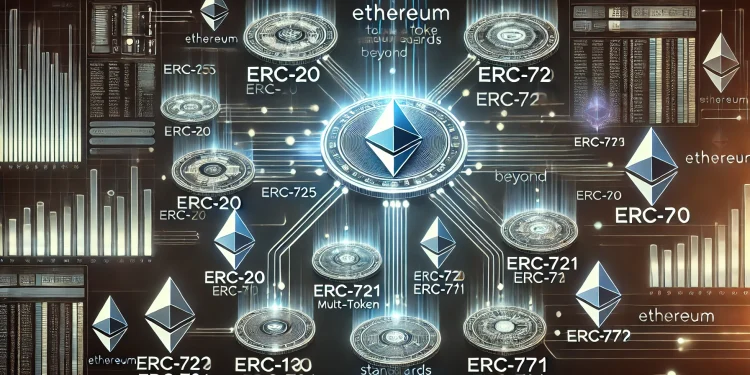The non-fungible token (NFT) phenomenon has become one of the most transformative trends in blockchain technology, revolutionizing industries such as art, gaming, music, and real estate. At the heart of this boom lies Ethereum, the blockchain that pioneered the use of smart contracts and enabled the creation of NFTs. While other blockchains like Solana and Tezos have entered the NFT space, Ethereum remains the dominant platform driving most of the activity.
This article takes a deep dive into Ethereum’s role in the NFT revolution, exploring how its infrastructure enables NFTs, the key projects that have thrived on the network, and the challenges it faces in maintaining its leadership in the space.
What Are NFTs, and Why Are They Revolutionary?
NFTs are unique digital assets recorded on a blockchain. Unlike cryptocurrencies like Bitcoin or Ethereum’s native ETH, which are fungible (each unit is identical and interchangeable), NFTs are non-fungible, meaning each one is distinct and holds individual value. NFTs can represent anything from digital art and collectibles to in-game items, music, or real-world assets like real estate.
This tokenization of uniqueness has opened new markets by enabling artists, musicians, and creators to directly monetize their work. The appeal of NFTs lies in their ability to prove ownership, provenance, and authenticity, using blockchain technology to create digital scarcity.
Why Ethereum Became the NFT Hub
Ethereum’s blockchain architecture and smart contract functionality make it the perfect platform for NFTs. Several factors contributed to Ethereum’s early dominance and continued leadership in the NFT ecosystem.
1. Smart Contracts and ERC-721 Standard
Ethereum was the first blockchain to introduce smart contracts, self-executing programs that automate transactions when predefined conditions are met. The NFT boom was made possible by Ethereum’s ERC-721 token standard, which ensures each token is unique and indivisible.
This token standard is critical for the creation of NFTs and has enabled developers to create marketplaces, gaming assets, and collectibles directly on the Ethereum blockchain. The ERC-1155 standard, introduced later, added even more flexibility, allowing both fungible and non-fungible tokens to coexist within a single smart contract, further streamlining the NFT development process.
2. Composability and Interoperability
Ethereum’s composability allows developers to interlink different DeFi and NFT protocols seamlessly. Projects such as OpenSea, Rarible, and Decentraland can interoperate, allowing users to trade NFTs from one platform to another effortlessly. This interconnected ecosystem fosters innovation and enhances liquidity, as users can access a broad range of services without leaving the Ethereum environment.
3. Developer and User Network Effects
Ethereum’s large developer community and early lead in blockchain adoption gave it a significant edge in the NFT space. As developers built marketplaces and NFT tools on Ethereum, these platforms naturally attracted artists, creators, and collectors. OpenSea, the largest NFT marketplace, was born on Ethereum and still handles the bulk of NFT transactions, even as it expands to other chains.
Additionally, Ethereum’s wide user base and familiarity with wallets like MetaMask helped onboard new users into NFTs, making it the go-to blockchain for creators and investors alike.
4. High-Profile NFT Sales and Celebrity Adoption
Many high-profile NFT drops, such as Beeple’s $69 million digital artwork auctioned by Christie’s, were conducted on Ethereum, cementing its status as the premier platform for digital art. Celebrity involvement from figures like Snoop Dogg, Grimes, and Paris Hilton also helped attract mainstream attention, with most of their NFTs minted on Ethereum. The visibility and trust Ethereum enjoys have played a pivotal role in building confidence in the NFT space.
Key Ethereum-Based NFT Projects and Marketplaces
1. OpenSea
OpenSea is the largest and most influential NFT marketplace, offering a platform where users can buy, sell, and mint NFTs. As an Ethereum-based platform, OpenSea has facilitated billions of dollars in NFT trades, supporting everything from art collections and gaming assets to virtual real estate.
2. CryptoPunks
CryptoPunks is one of the earliest and most iconic NFT projects, offering 10,000 algorithmically generated characters. Initially distributed for free, these NFTs now trade for millions of dollars. CryptoPunks became a symbol of the NFT art movement and demonstrated the power of tokenized collectibles.
3. Bored Ape Yacht Club (BAYC)
BAYC is a collection of 10,000 unique cartoon apes, each with distinctive traits. These NFTs not only serve as collectibles but also provide access to exclusive community events and virtual spaces, highlighting how NFTs can extend beyond art into membership and utility.
4. Decentraland
Decentraland is a virtual world built on Ethereum where users can purchase, trade, and monetize virtual real estate. NFTs represent ownership of plots of land, in-game items, and digital wearables, offering a glimpse into the future of metaverse experiences.
Challenges Ethereum Faces in the NFT Space
Despite Ethereum’s success, the blockchain faces several challenges in maintaining its leadership in the NFT ecosystem.
1. High Gas Fees
Ethereum’s congestion and high transaction fees (known as gas fees) have been a persistent issue. During periods of heavy demand, such as popular NFT drops, gas fees can skyrocket, making it expensive for users to mint or trade NFTs. This has led some projects and users to migrate to alternative blockchains like Solana, Tezos, and Polygon, which offer lower fees and faster transactions.
2. Scalability Issues
Ethereum has struggled with scalability, limiting its ability to process a high volume of transactions efficiently. The transition to Ethereum 2.0, which introduces Proof of Stake and sharding, aims to address these issues by increasing throughput and reducing fees. Layer-2 solutions like Arbitrum and Optimism are also being adopted to enhance Ethereum’s scalability.
3. Environmental Concerns
Before the Ethereum Merge in 2022, the blockchain relied on the energy-intensive Proof of Work mechanism, drawing criticism for its environmental impact. While Ethereum’s move to Proof of Stake has significantly reduced energy consumption, the network must continue to improve its sustainability to maintain its competitive edge.
Ethereum’s Future in the NFT Ecosystem
Despite these challenges, Ethereum remains at the forefront of the NFT revolution. With Ethereum 2.0 and Layer-2 solutions addressing scalability and fee issues, the blockchain is better positioned to handle future growth. Additionally, cross-chain interoperability efforts, such as bridges to Solana, Polygon, and Tezos, ensure that Ethereum will remain relevant even as new blockchains emerge.
Ethereum’s role in the metaverse is also expected to grow, with virtual worlds like Decentraland and platforms like The Sandbox gaining traction. NFTs are likely to become even more embedded in entertainment, real estate, and gaming industries, further expanding Ethereum’s influence.
Conclusion: Ethereum as the Backbone of the NFT Boom
Ethereum’s smart contract capabilities, strong developer ecosystem, and network effects have made it the undisputed leader in the NFT space. While new blockchains are challenging its dominance, Ethereum’s early adoption, high-profile projects, and continuous innovation ensure it will remain a key player in the NFT ecosystem for the foreseeable future.
With the ongoing transition to Ethereum 2.0, improved scalability, and growing interoperability, Ethereum is well-positioned to maintain its leadership in the evolving world of NFTs. Whether through digital art, gaming, or virtual real estate, Ethereum-based NFTs are set to play a significant role in the future of digital ownership and creativity. As NFTs continue to gain mainstream attention, Ethereum’s role as the backbone of the NFT revolution will only grow stronger.







